





You had been warned, the Acanthaceae is an extensive family with many noteworthy members; here are a few more
Indeed, with over 2500 species we can pay numerous visits to this family; the four of them we met in a previous article were a mere introduction, now the only trouble will be which ones should we meet? Ah well, let us go in the garden and see what we stumble on!
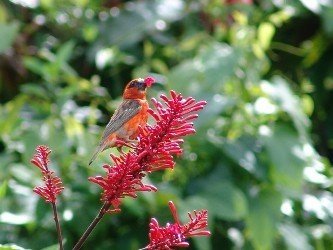 And yes, just as we step outside the corner of the verandah we catch a glimpse of this bright red birdie flying away...and we obviously disturbed his breakfast consisting of nectar from Odontonema cuspidatum, one of the 26 species of this relatively small genus. Also named with the synonym of Justicia coccinea (remember from your old school Latin classes that "coccinea" means "red") it bears the vernacular names of ‘scarlet fire-spike' and ‘cardinal's crest' which already give you clues on its general appearance. By the way, the little nectar-eater we bothered a minute ago is called "cardinal" as well because of its bright red costume. Back to our plant which comes from Central America and will reach 5 to 6 feet in height, a perfect size if you need a small hedge or if your garden is not that large. The leaves are oblong and shiny, the flowers have a tube-shape, they are bright red and are held in erect panicles (another word for spike). As the birdie clearly reveals, this species is attractive to birds (especially hummingbirds) and butterflies. It can be easily clipped with shears so as to make a well-groomed hedge and will be happy in full sun.
And yes, just as we step outside the corner of the verandah we catch a glimpse of this bright red birdie flying away...and we obviously disturbed his breakfast consisting of nectar from Odontonema cuspidatum, one of the 26 species of this relatively small genus. Also named with the synonym of Justicia coccinea (remember from your old school Latin classes that "coccinea" means "red") it bears the vernacular names of ‘scarlet fire-spike' and ‘cardinal's crest' which already give you clues on its general appearance. By the way, the little nectar-eater we bothered a minute ago is called "cardinal" as well because of its bright red costume. Back to our plant which comes from Central America and will reach 5 to 6 feet in height, a perfect size if you need a small hedge or if your garden is not that large. The leaves are oblong and shiny, the flowers have a tube-shape, they are bright red and are held in erect panicles (another word for spike). As the birdie clearly reveals, this species is attractive to birds (especially hummingbirds) and butterflies. It can be easily clipped with shears so as to make a well-groomed hedge and will be happy in full sun.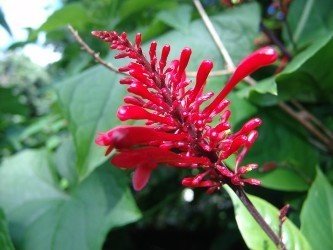
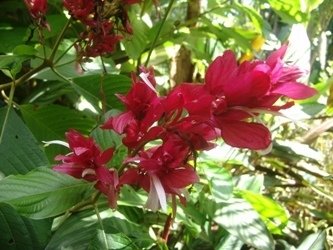 Let us calmly walk a few meters away to let this hungry cardinal resume his breakfast and stop in front of another medium-sized plant. You will have again to dust off your Latin and take a large lungful of air for its name which is Megaskepasma erythrochlamys, for once the only species amongst its genus, originating from Venezuela even though it is often called ‘Brazilian red cloak'. This one has much larger leaves than the first plant we saw, with a pale green shade, the plant itself is also somewhat larger, growing to 8 or 12 feet. Flowers are quite showy, tubular, white to pale pink, surrounded by the impressive bracts which are bright red to magenta and also stay for a long time seemingly for the keen gardener's joy. Although it is stated in a rather serious and highly recommended book (Tropical Flowering Plants by Kirsten Albrecht Llamas, Timber Press) that ‘it is not known to produce seeds in cultivation' I can assure you that it does for me and it has done so to such an extent that my neighbor is now enjoying a nice flowering bush she never planted...she is very happy but it implies that the species is a potential invader and should be carefully monitored.
Let us calmly walk a few meters away to let this hungry cardinal resume his breakfast and stop in front of another medium-sized plant. You will have again to dust off your Latin and take a large lungful of air for its name which is Megaskepasma erythrochlamys, for once the only species amongst its genus, originating from Venezuela even though it is often called ‘Brazilian red cloak'. This one has much larger leaves than the first plant we saw, with a pale green shade, the plant itself is also somewhat larger, growing to 8 or 12 feet. Flowers are quite showy, tubular, white to pale pink, surrounded by the impressive bracts which are bright red to magenta and also stay for a long time seemingly for the keen gardener's joy. Although it is stated in a rather serious and highly recommended book (Tropical Flowering Plants by Kirsten Albrecht Llamas, Timber Press) that ‘it is not known to produce seeds in cultivation' I can assure you that it does for me and it has done so to such an extent that my neighbor is now enjoying a nice flowering bush she never planted...she is very happy but it implies that the species is a potential invader and should be carefully monitored.
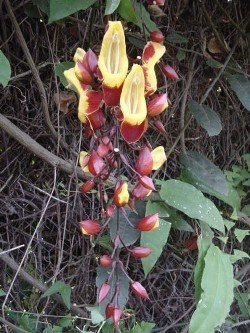 I guess we can stop and sip some tea underneath my new bower, we will enjoy both the shade and the next species to admire. This one suits perfectly bowers and arbours as it is a vine and its flowers are pendulous, therefore you either have to grow it on a tree which it would soon cover and possibly destroy or on some sort of prop. Thunbergia mysorensis is one of the 90 species of the genus which numbers several climbers, they come from Africa and India, the species name here clearly refers to Mysore, the second largest city of Karnataka state in Southern India. Known as ‘Munzerabad creeper' and ‘clock vine' this woody vine will reach some 20 feet long if left un-pruned. The leaves are narrow, bright green, ending in a point, with two small lobes at the basis looking like small knives. The flowers are again quite showy and original both in the shape and color they display. They look like hoods which inner part is yellow and the outer part red to mahogany, the bracts are the same color as the outer part. Those flowers are born on pendant racemes up to one foot long, often swaying with the wind or when birds feed on the abundant nectar held in the large curved flowers. The plant will enjoy full sun but can also be grown in semi-shaded areas on well drained grounds. Surprisingly enough for a tropical plant it is able to withstand cold temperatures and may grow back from its roots if the aerial part was to be killed by a cold spell.
I guess we can stop and sip some tea underneath my new bower, we will enjoy both the shade and the next species to admire. This one suits perfectly bowers and arbours as it is a vine and its flowers are pendulous, therefore you either have to grow it on a tree which it would soon cover and possibly destroy or on some sort of prop. Thunbergia mysorensis is one of the 90 species of the genus which numbers several climbers, they come from Africa and India, the species name here clearly refers to Mysore, the second largest city of Karnataka state in Southern India. Known as ‘Munzerabad creeper' and ‘clock vine' this woody vine will reach some 20 feet long if left un-pruned. The leaves are narrow, bright green, ending in a point, with two small lobes at the basis looking like small knives. The flowers are again quite showy and original both in the shape and color they display. They look like hoods which inner part is yellow and the outer part red to mahogany, the bracts are the same color as the outer part. Those flowers are born on pendant racemes up to one foot long, often swaying with the wind or when birds feed on the abundant nectar held in the large curved flowers. The plant will enjoy full sun but can also be grown in semi-shaded areas on well drained grounds. Surprisingly enough for a tropical plant it is able to withstand cold temperatures and may grow back from its roots if the aerial part was to be killed by a cold spell.
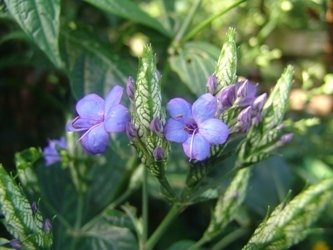 The fourth member is not a common sight in gardens although it does deserve more attention and will without question be enjoyed whenever it becomes more widely available in nurseries and garden-centers. It belongs to the Eranthemum genus which only numbers some 30 species from tropical Asia, all either shrubs or sub-shrubs. Flowers are usually small but they come in large numbers hence an interesting decorative feature. The one we are standing in front is Eranthemum pulchellum (synonyms Eranthemum nervosum and Pseuderanthemum pulchellum) coming from India, often miscalled ‘blue sage' because the leaves remind of such a plant. Anyway, although it is not a sage it is indeed blue, a bright deep blue set amongst small green and white veined bracts. It will grow to some three or four feet high, with a quite branched habit and will enjoy bright spots and loose humus-rich soil. Propagation will be done by sowing or cuttings which will be in abundance as the plant can be sharply pruned after flowering.
The fourth member is not a common sight in gardens although it does deserve more attention and will without question be enjoyed whenever it becomes more widely available in nurseries and garden-centers. It belongs to the Eranthemum genus which only numbers some 30 species from tropical Asia, all either shrubs or sub-shrubs. Flowers are usually small but they come in large numbers hence an interesting decorative feature. The one we are standing in front is Eranthemum pulchellum (synonyms Eranthemum nervosum and Pseuderanthemum pulchellum) coming from India, often miscalled ‘blue sage' because the leaves remind of such a plant. Anyway, although it is not a sage it is indeed blue, a bright deep blue set amongst small green and white veined bracts. It will grow to some three or four feet high, with a quite branched habit and will enjoy bright spots and loose humus-rich soil. Propagation will be done by sowing or cuttings which will be in abundance as the plant can be sharply pruned after flowering.
Well, it's time to let you go back home with a handful of seeds and cuttings to see how green your thumbs are. As promised, we will meet quite a few more Acanthaceae members in the next future!
Copyright © www.100flowers.win Botanic Garden All Rights Reserved